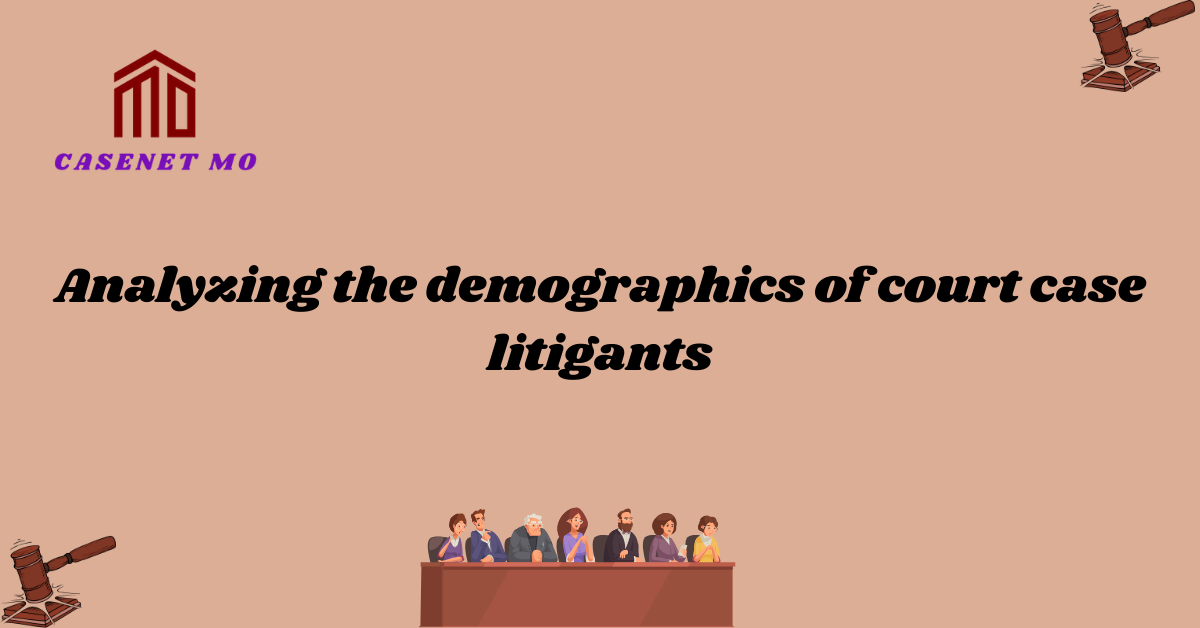Analyzing the demographics of court case litigants
At the heart of every courtroom lies a diverse tapestry of individuals, each with their own unique stories and circumstances. From the plaintiff seeking justice to the defendant fighting to defend their rights, the demographics of court case litigants are as varied as the cases themselves. Understanding and analyzing these demographics is crucial to gaining a comprehensive understanding of the judicial system and the challenges it faces.
By delving into the demographics of court case litigants, we uncover a wealth of valuable insights that shed light on the dynamics of law and society. From examining the age, gender, and socioeconomic backgrounds of litigants to exploring the disparities in access to justice, this analysis serves as a powerful tool for addressing the complexities of our legal system. Join us as we delve into the intricate world of court case demographics, uncovering the stories that shape our judiciary and the people it serves.
Uncovering the Age Demographics
Age plays a significant role in court case demographics, as it often influences the types of legal disputes. By examining the age of litigants, we can gain insights into the social and economic factors that contribute to their involvement in the judicial system. From young adults facing criminal charges to elderly individuals seeking justice in civil matters, the age demographics of court cases reveal a diverse range of legal challenges.
Exploring Gender Disparities
Gender disparities within the court system have long been a topic of discussion and analysis. By delving into the demographics of litigants, we can shine a light on these disparities and work towards creating a more equitable judicial system. From examining the representation of men and women in different types of cases to analyzing the biases that may exist within court proceedings, understanding gender demographics is crucial in promoting fairness and equality in the legal realm.
The Socioeconomic Impact
The socioeconomic backgrounds of court case litigants can have a profound impact on their experiences within the judicial system. By analyzing the demographics of litigants, we can uncover the disparities in access to justice that exist based on income, education, and social status. This analysis allows us to identify areas where improvements can be made to ensure that every individual, regardless of their socioeconomic background, has equal access to a fair and impartial legal process.
Disparities in Access to Justice
Examining the demographics of court case litigants also reveals the disparities in access to justice that exist within our legal system. By analyzing the representation of different socioeconomic groups, ethnicities, and geographical regions, we can identify the areas where individuals may face challenges in accessing legal resources and representation. This understanding informs efforts to promote equal access to justice for all, regardless of their circumstances.
Addressing the Challenges
The complexities of our legal system are shaped by the demographics of court case litigants. By delving into these demographics, we gain a deeper understanding of the judicial system’s challenges. From identifying areas of improvement to promoting equality and fairness, this analysis is a powerful tool for addressing the complexities of our legal system. Join us as we continue to explore the intricate world of court case demographics, uncovering the stories that shape our judiciary and the people it serves.
FAQs
What role does age play in court case demographics?
Age plays a significant role in court case demographics, as it often influences the types of legal disputes. By examining the age of litigants, we can gain insights into the social and economic factors that contribute to their involvement in the judicial system. From young adults facing criminal charges to elderly individuals seeking justice in civil matters, the age demographics of court cases reveal a diverse range of legal challenges.
What’s the significance of examining gender gaps in courts?
Gender disparities within the court system have long been a topic of discussion and analysis. By delving into the demographics of litigants, we can shine a light on these disparities and work towards creating a more equitable judicial system. From examining the representation of men and women in different types of cases to analyzing the biases that may exist within court proceedings, understanding gender demographics is crucial in promoting fairness and equality in the legal realm.
What’s the influence of socioeconomic status on court cases?
The socioeconomic backgrounds of court case litigants can have a profound impact on their experiences within the judicial system. By analyzing the demographics of litigants, we can uncover the disparities in access to justice that exist based on income, education, and social status. This analysis allows us to identify areas where improvements can be made to ensure that every individual, regardless of their socioeconomic background, has equal access to a fair and impartial legal process.
What justice access gaps exist in law?
Examining the demographics of court case litigants also reveals the disparities in access to justice that exist within our legal system. By analyzing the representation of different socioeconomic groups, ethnicities, and geographical regions, we can identify the areas where individuals may face challenges in accessing legal resources and representation. This understanding informs efforts to promote equal access to justice for all, regardless of their circumstances.
How does studying court demographics aid legal system challenges?
The complexities of our legal system are shaped by the demographics of court case litigants. By delving into these demographics, we gain a deeper understanding of the challenges that the judicial system faces. From identifying areas of improvement to promoting equality and fairness, this analysis serves as a powerful tool in addressing the complexities of our legal system. Join us as we continue to explore the intricate world of court case demographics, uncovering the stories that shape our judiciary and the people it serves.







